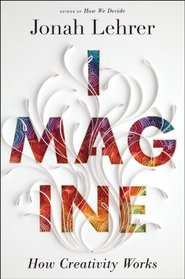Review first published on my blog: http://memoriesfrombooks.blogspot.com/2012/04/imagine-how-creativity-
Imagine: How Creativity Works states: "The science of imagination doesn't fit neatly on a PowerPoint slide, and it can't be summarized in a subtitle ... Despite all the clever studies and rigorous experiments, our most essential mental talent remains the most mysterious." As the quote suggests, the author recognizes our inability to define and confine imagination into one definition. No one can tell you completely or exactly how creativity works.
Jonah Lehrer then set him self a daunting task by subtitling the book "how creativity works". The book cannot wrap creativity into a neat package, but it does explore creativity from different perspectives - the neuroscience of individuals, the process of collaboration, the culture of an organization that supports creativity, and issues that impact our society's current and future ability to be creative.
The topic itself is fascinating. What makes the book fun to read is the research Jonah Lehrer cites. The book brings in anecdotes about people from ranging from Shakespeare to Bob Dylan and organizations ranging from Disney to 3M to entire cities. I enjoyed the stories.
Sometimes, however, I was unsure where the book was going or what the central tenet was. Different sections spoke to different conditions giving rise to creative thought. Solitary seaside walk versus collaborative conferences. Creative works being produced in a drug induced haze (this idea, while cited from examples, particularly makes me cringe as a parent) versus caffeine acting as a deterrent to creativity in other situations.
I suppose these seeming contradictions go back to the central idea that creativity cannot be completely defined or processed. It can differ from person to person and situation to situation. However, I did not need this book to tell me that. I knew that going in. That was part of the reason for reading the book - to see if a further framework could be put around the topic. So, I enjoyed reading the book but don't know that I learned much that was new.
The final part of the book is definitely a call to action. For us as individuals. For our schools. For our governments. For our society. How do we foster a culture in which creativity can flourish? I hope this book spurs that discussion. If it does, that may be where the success of this book lies.
Imagine: How Creativity Works states: "The science of imagination doesn't fit neatly on a PowerPoint slide, and it can't be summarized in a subtitle ... Despite all the clever studies and rigorous experiments, our most essential mental talent remains the most mysterious." As the quote suggests, the author recognizes our inability to define and confine imagination into one definition. No one can tell you completely or exactly how creativity works.
Jonah Lehrer then set him self a daunting task by subtitling the book "how creativity works". The book cannot wrap creativity into a neat package, but it does explore creativity from different perspectives - the neuroscience of individuals, the process of collaboration, the culture of an organization that supports creativity, and issues that impact our society's current and future ability to be creative.
The topic itself is fascinating. What makes the book fun to read is the research Jonah Lehrer cites. The book brings in anecdotes about people from ranging from Shakespeare to Bob Dylan and organizations ranging from Disney to 3M to entire cities. I enjoyed the stories.
Sometimes, however, I was unsure where the book was going or what the central tenet was. Different sections spoke to different conditions giving rise to creative thought. Solitary seaside walk versus collaborative conferences. Creative works being produced in a drug induced haze (this idea, while cited from examples, particularly makes me cringe as a parent) versus caffeine acting as a deterrent to creativity in other situations.
I suppose these seeming contradictions go back to the central idea that creativity cannot be completely defined or processed. It can differ from person to person and situation to situation. However, I did not need this book to tell me that. I knew that going in. That was part of the reason for reading the book - to see if a further framework could be put around the topic. So, I enjoyed reading the book but don't know that I learned much that was new.
The final part of the book is definitely a call to action. For us as individuals. For our schools. For our governments. For our society. How do we foster a culture in which creativity can flourish? I hope this book spurs that discussion. If it does, that may be where the success of this book lies.




